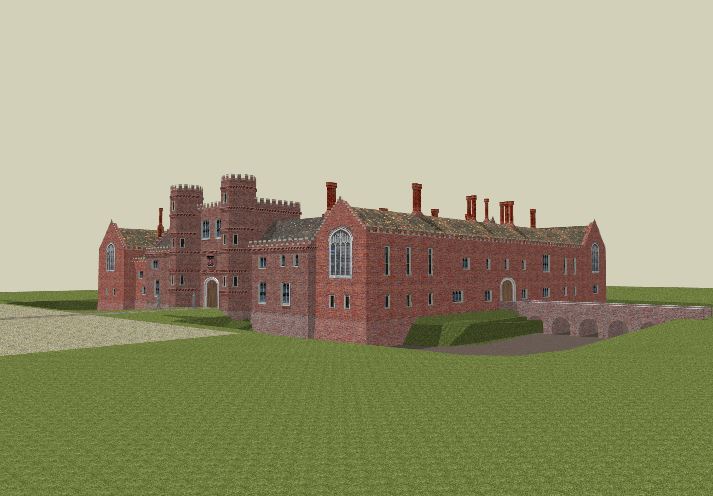 Picture by Michael Athanson
Picture by Michael Athanson
The More was a palace near Rickmansworth which had been built in the early fifteenth century and was extended in the early sixteenth century. In the eighth century, the manor of the More was among the sites in south-west Hertfordshire given by King Offa to the Abbey of St Albans. At one time it was ranked amongst the most impressive of the later medieval houses of noblemen and high churchmen, and was comparable in its prime with Hampton Court Palace.
Over the years the More was had a number of well-known owners and short-term residents. King Henry VIII celebrated the Treaty of the More – a peace treaty between England and France – at the Manor in 1525, when the house was owned by Henry’s most trusted advisor, Cardinal Thomas Wolsey. In late 1521 Wolsey, who was also Abbot of St Albans, took over the More and in 1529 it passed to Henry, after Wolsey’s downfall.
As Henry’s advisor, Wolsey was responsible for making the King’s wishes a reality. He organised much of the Field of the Cloth of Gold, a grandiose meeting between Francis I of France and Henry VIII, accompanied by 5,000 followers. This meeting opened the door to peaceful negotiations with France.
Wolsey’s finest achievement is said to be the Treaty of London, which was signed by the major European nations as an agreement not to attack one another and to come to the aid of any that were under attack.
Wolsey met his downfall when he failed to provide an annulment for Henry VIII and his first wife, Catherine of Aragon. Henry and Catherine’s marriage had provided no sons that survived beyond infancy. They had a daughter, Mary, but she was not considered capable of ruling the country; at this time, England had never accepted a queen regnant.
Henry expressed the belief that Catherine’s inability to produce a viable male heir was due to her being the widow of his elder brother, Arthur. He had obtained a papal dispensation allowing him to marry Catherine, but now declared that this was invalid because it was based upon the claim that Catherine was still a virgin after her first husband’s death. Henry argued that Catherine’s claim was not credible and their marriage must therefore be annulled.
Aside from his desperation for a son, Henry’s desire for one of his wife’s ladies-in-waiting, Anne Boleyn, contributed to his lobbying for an annulment.
Catherine maintained that she had been a virgin when she married Henry and defiantly refused to retire to a nunnery. The annulment request became a matter of international diplomacy. Catherine had powerful friends on her side, including her nephew, Holy Roman Emperor Charles V, who pressured the Pope not to annul his aunt’s marriage.
Pope Clement VII could either anger Charles or anger Henry. In the end, he decided he would do neither, and left the decision to two papal legates, one of whom was Cardinal Wolsey, the owner of the Manor of the More.
Wolsey’s failure to secure the annulment led to his downfall and arrest. It was rumoured that Anne Boleyn convinced Henry that Wolsey was deliberately slowing proceedings because of his personal aversion to her. Wolsey was stripped of his government office and property, and later died of an illness on his way to London to answer a charge of high treason.
Thomas Cranmer, Archbishop of Canterbury, declared Henry and Catherine’s marriage illegal. Henry married Anne Boleyn in a secret ceremony before this verdict was given.
Until the end of her life, Catherine referred to herself as Henry’s only lawful wedded wife and England’s rightful queen.
The annulment had far-reaching consequences, and led to the break with Rome and the establishment of the Church of England. Henry and Catherine’s only surviving child, Mary, became the first queen regnant of England in 1553. A staunch Catholic, her executions of Protestants led to the nickname ‘Bloody Mary’.
Catherine of Aragon lived at the Manor of the More for a short time after the annulment of her marriage to Henry. Two deer barns were built on the grounds, and there were two grandstands to watch the hunting.
The Manor of the More was abandoned after 1556, and demolished probably in the 1570s. Nothing remains above ground. The site is now a playing field for Merchant Taylors’ Preparatory School.
http://www.northwoodprep.co.uk/virtual_tour.html
Article taken from the Watford Observer Nostalgia Series by Kelly Pells.
Reproduced courtesy of The Watford Observer
http://www.watfordobserver.co.uk/news/nostalgia/memories/
Additional information provided by Dr Heather Falvey Chairman Rickmansworth Historical Society
